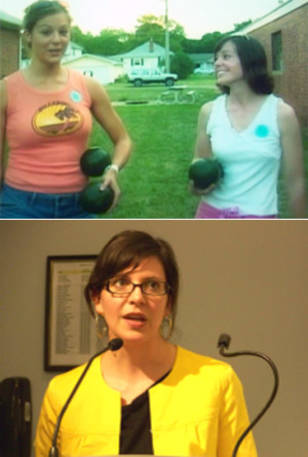Bocce ball is the sport of Italian old men. The very name conjures images of pot-bellied curmudgeons in speedos, with deep tans and cigarettes dangling from their lips, playing an afternoon round on a beach on the Adriatic coast. I always believed the inherent uncoolness of bocce, given its association to the denture-wearing cohort, assured it would never be popular anyplace beyond Italian shores.
And yet, there is a place: the landlocked little town of Toluca, Illinois.
“Watch the Pallino”, a documentary screened Wednesday March 5th at the CUNY Graduate School of Journalism and presented by Joe Sciorra of the John Calandra Institute, traces the peculiar history of the bocce craze in Toluca. Director Stephanie Foerster returned to her mother’s hometown to capture the annual Labor Day weekend bocce tournament, and through interviews with residents, shed light on how the favorite summer sport of Italian seniors made its way across the continents.
Thirty-four-year-old Foerster dedicated her documentary to her grandfather, also a Tolucan, and her love of the town shows. She wanted to convey something essential about the place and found it in the community’s brimming passion for bocce, a sport (or hobby, if one prefers) practiced by nearly every Tolucan, man, woman, or child, with a set of hands.
Bocce ball was introduced at the turn of the century by Italian immigrants. They flocked to Illinois in search of opportunity and were hired as miners in Toluca, often playing bocce after work around the town’s drinking holes. Soon the “lawn bowling” fever caught on, and it can very well be said that the social sport— because the beauty of it is that anyone can play, even with a few drinks in ‘im— helped bridge relations between the Italians and the town’s mostly German-English population.
Today, to accommodate the 256 teams that sign up for the Labor Day tournament, any old space will do. The favored grassy plots are optional (some will even brave passing cars to play along asphalt streets), but a ready supply of beer isn’t. The tournament’s more competitive players may need a mug here or there to take the edge off. Shirley, a tempestuous woman in her sixties and one of the movie’s more memorable characters, bitterly acknowledges a loss to some young women: “We lost to a couple of whipper-snappers!” Later she’ll console herself with a tall, cold glass of pale ale.
Against a score of dramatic Sicilian melodies, or upbeat folk tunes from southern Italy, kids, twenty-somethings (who feel they have to step up their game, because “the old men will beat you silly”) and septuagenarians all face off in a series of matches. Although the musical choice pays homage to the sport’s Italian origins, Foerster also uses it to reflect an overlapping of past and present, transformation and assimilation. As she put it, “No one in Toluca is saying ‘I’m in this ‘cause I’m Italian’”, or no one plays to sample Italian culture. If anything, people play to get closer to their next-door neighbor. Many Tolucans add that for them, playing bocce is a way of re-connecting with the town as a whole—the young with the old, those who have moved away with those who stayed behind. Every community is sustained by at least one common cause—be it church, school or mud-wrestling. It just so happens that in Toluca it’s bocce ball, or as some there say, “butchy ball”.
Foerster sagely allows for the experience of the town and its people to unfold organically, with long shots of games, close-ups of sneakers in the grass, players’ fervent stares and fluttering t-shirts with “Toluca Bocce Club” emblazoned on the front. The characters themselves speak candidly, at times comically, to the camera, and with what seems like very little manipulation from the filmmakers. It’s a veritable open window onto interactions between players and generations, a perfectly preserved slice of Americana. And some Tolucans, not without self-awareness, do their own philosophizing on the bocce trend. One observes: “Bocce is most like life”, referring to the unpredictability of the game, “Everything’s going fine and then one day, all of a sudden, you get a letter that somebody’s been in a car crash or that, I don’t know, your son’s been thrown in jail.” Could the reasons for playing be socio-anthropological, existential even? Another asserts that “the Romans and the Egyptians played. It’s said that even prehistoric man played bocce with rocks.”
Back in the modern world bocce ball may be seeing a resurgence. Among the audience of about 40 people present at the screening you could hear murmurs and echoes about the goings-on of the New York bocce world. One eager woman informed that in some bars in Brooklyn, where she goes on the weekends, you can play bocce. Another added nostalgically: “What they’re doing in Toluca is great. When I was a kid my grandfather used to take me to bocce courts in the Bronx all the time. Now they’re filled with weeds.”


